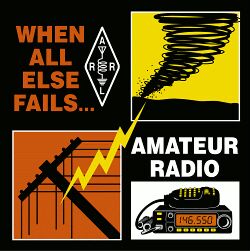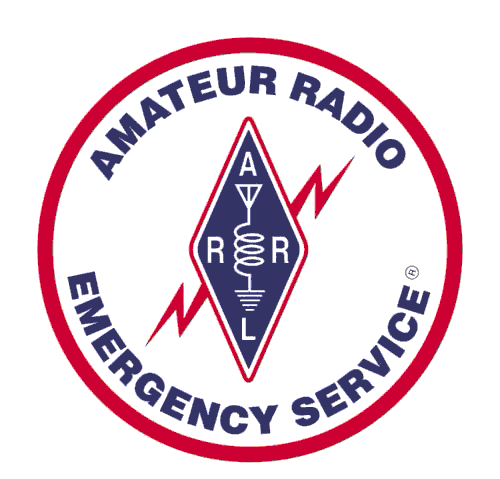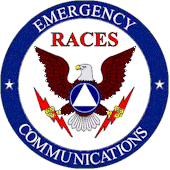Glossary
List of terms and acronyms you are likely to encounter when working in emergency communications.
- ACS - Auxiliary Communications Service
This State of California program called ACS was changed to Communication Reserve Unit (CRU) in April of 2017. See CRU. - ADEC - Assistant District Emergency Coordinator
An assistant to the DEC. - AEC - Assistant Emergency Coordinator
An assistant to the EC. - AlertSCC
AlertSCC is a free and easy way to get emergency alerts sent directly to your cell phone or mobile device, landline, or email. Alerts can include information about: Fire, Earthquake, Severe weather, Crime incident that affects your neighborhood and/or instructions during a disaster? Alerts are sent by the local city or county to alert residents. - Anderson Power Pole
State of California OES prescribes the Anderson Power Pole as the standard DC power connector for use by State ACS/RACES personnel, and recommends its use by County and City RACES personnel as well. Using this standard, highly reliable connector allows quick and easy installation and substitution of radios, power supplies, batteries, and other equipment. - APRS - Automatic Packet Reporting System
Sometimes incorrectly called Automatic Position Reporting System, APRS is a communications protocol that allows stations to send location, weather and other data real-time. - ARRL - American Radio Relay League
The national association of amateur radio in the United States. With more than 161,000 members, ARRL is the largest organization of radio amateurs in the world. ARRL's mission is based on five pillars: Public Service, Advocacy, Education, Technology, and Membership. - CAL FIRE - California Department of Forestry and Fire Protection
CAL FIRE protects lives, property and natural resources from fire; responds to emergencies of all types, and protects and preserves timberlands, wildlands, and urban forests and provides varied emergency services in 36 of the State's 58 counties via contracts with local governments. - CAP - Civil Air Patrol (145.150 MHz)
- CDF - California Department of Forestry
Sometimes used to refer to CAL FIRE which is part of the CDF. - CERT - Community Emergency Response Team
The CERT program educates volunteers about disaster preparedness for the hazards that may impact their area and trains them in basic disaster response skills, such as fire safety, light search and rescue, team organization, and disaster medical operations. - Chief
The ICS title for individuals responsible for command of functional sections: Operations, Planning, Logistics, and Finance/Administration. Also used to designate the highest ranking position in a department - Police or Fire Chief. - Credential
The Credential Program defines standards of performance and includes several types and levels of qualifications. These qualifications are the basis for resource typing and effective and efficient resource assignment. Credentials are earned by participation in training classes, exercises, public service events, and a peer-review of operator performance. - CRO - Chief Radio Officer
The appointed leader by a governemnt agency of a RACES group. See also EC and DEC. - CRU - Communications Reserve Unit formerly ACS.
CRU is an all-volunteer Emergency Communications (EMCOMM) organization, providing support to the Telecommunications Branch (TCOMM) of the Governor's Office of Emergency Services (Cal OES). - DEC - District Emergency Coordinator
An appointed ARRL official who directs the emergency Amateur Radio efforts within a district, in our case the county. In Santa Clara County the ARES DEC is also the RACES Chief Radio Officer (CRO). (The DEC for Santa Clara County is Tim Howard, KE6TIM). - DOC - Department Operations Center
An location where incidents are managed for a department or organization. I.E., Water District, Hospital, Health Center, etc. - DSW - Disaster Service Worker
To work under a RACES activation you need to be registered as a DSW by the governmental agency you are working for. The DSW registration provides workers compensation and liability insurance coverage when activated by that agency. - DSW ID Card
Identification card issued by the government agency you have registered with as a Disaster Service Worker. - EAS - Emergency Alert System
An emergency broadcast system using public communications (TV and radio) to alert the general public to an emergency situation. - EC - Emergency Coordinator
An appointed ARRL official who directs the emergency Amateur Radio efforts within a geographic area, in our case a city. Within Santa Clara County the ARES EC is also the RACES Chief Radio Officer (CRO). (The EC/CRO for Milpitas is Paul Ellis, KM6IAO). - EOC - Emergency Operations Center
A location within a city, county, state or agency from which emergency operations are directed. - EMA - Emergency Managers Association
A committee whose membership consists of the managers of all city Offices of Emergency Services in the County, the manager of the County Office of Emergency Management (OEM), and the Emergency Managers of allied organizations. - EmComm - Emergency Communications
A general term referring to the act of or the person providing communications services during an emergency. - FEMA - Federal Emergency Management Agency
The federal government agency concerned with disaster preparation and disaster recovery. - First Responder
The first person or agency to be sent to the scene of an emergency. This is fire, law enforcement, or emergency medical personnel. - FRS - Family Radio Service
An unlicensed personal radio service in the UHF band. All radios in this service must be hand-held units transmitting no more than 1/2 watt. - GMRS - General Mobile Radio Service
A licensed personal radio service in the UHF band. For the price of the license fee (there is no exam) you may set up base, mobile, and/or repeater systems running up to 50 watts. - Go-Bag/Go-Kit
A bag or pack that has your "call-out" gear (emergency activation gear). Suggested Go-Kit contents. - ICP - Incident Command Post
The location at which the primary command functions are executed. The ICP may be co-located with the incident base or other incident facilities. - ICS - Incident Command System
A management tool to bring multiple agencies together under one command structure during an emergency. - MAC - Mutual Aid Communicator
Credentialed amateur radio operators who are also willing and able to be assigned to another city or agency in the county. - MARS - Military Affiliate Radio System
A military-run radio system that uses frequencies close to the amateur radio bands. MARS sometimes interacts directly with amateur radio, especially for message handling. - Mesh Networking -
The use of microwave frequencies in the Amateur Radio Bands to create a fault tolerant wireless network for the purpose of sending high speed digital data. - MOU - Memorandum Of Understanding
A written agreement between two organizations describing their cooperative efforts. For our purposes, a written agreement between ARES®/RACES groups and their Served Agency(ies). This agreement details what services will be provided by the ARES®/RACES group and what commitment the Served Agency makes in return. - Operational Area -
A State OES definition of the entire county, including the unincorporated county land together with all the cities and agencies within the county. Our operational area is Santa Clara County. - NC/NCS/NCO - Net Control / Net Control Station / Net Control Operator
A station, or more likely, an operator who is running a radio network. He or she is in charge with maintaining the orderly flow of traffic on the assigned net. - NIMS - National Incident Management System
NIMS is a comprehensive, national approach to incident management that is applicable at all jurisdictional levels and across functional disciplines. - NTS - National Traffic System
An ARRL-run network of operators who pass telegram-like messages throughout the United States. - NVIS - Near Vertical Incidence Skywave
An antenna system designed to send HF transmissions almost straight up, where they bounce off of the ionosphere and return to earth to cover a wide area around the sending station. - NWR - NOAA Weather Radio
The National Oceanographic and Atmospheric Administration's nationwide network of radio stations broadcasting continuous weather information direct from nearby National Weather Service offices. - OES / OEM - Office of Emergency Services / Office of Emergency Management
The organization at the state, county (Office of Emergency Management), or local government level charged with the responsibility for planning, preparation, and recovery from disaster operations. For Santa Clara County it is called the Office of Emergency Management (OEM) and in Milpitas it is OES. - Outpost
A program used within Packet Communications to provide a Windows based graphical user interface. See also PacItForms. - Packet Radio
A digital communications system using computers connected via Amateur Radio stations. Provides a reliable method for transmitting large amounts of data quickly and accurately. See also TNC. - PacItForms
An add-on to Outpost that provides a Windows browser based form that looks like the paper copies and WebEOC copies of the commonly used forms. - PIO - Public Information Officer
A person assigned to make public statements and handle queries from the press and public. - RACES - Radio Amateur Civil Emergency Service
Amateur radio groups organized by civil authorities to perform emergency communications. - Repeater
A station which receives transmissions from a mobile, portable, or fixed station and re-broadcasts them for extended range usually with higher output power. Generally located at a relatively high elevation. - Resource Net
A radio net organized for coordination of the movement and tracking of personnel and equipment. See also Tactical Net. - SATERN - Salvation Army Team Emergency Radio Network
The Salvation Army's internally managed amateur radio effort. - SEC - Section Emergency Coordinator
An appointed ARRL official who directs the emergency efforts within a section. The SEC for the Santa Clara Valley Section is _____________. - Served Agency
As an "emergency communicator" you will always be working for someone. You will be assisting a civil agency (police, fire, etcetera) or other emergency relief organization (hospital, Red Cross, etcetera). The agency or organization to which you provide communications services is the "served agency". - Shadow
Refers to radio operator assigned to a particular person or VIP to provide them with auxiliary communications. Your role is to follow them around like their shadow. - SEMS - Standardized Emergency Management System
The SEMS law, effective January 1, 1993, incorporates the use of the Incident Command System (ICS); the Fire Fighting Resources of California Organized for Potential Emergencies (FIRESCOPE) agreement; existing multi-agency and inter agency programs; the State's master Mutual Aid agreement and mutual aid program; the Operational Area concept. - Simplex
Refers to radio communications where both transmitter and receiver operate on a common frequency without the use of a repeater. - SOP - Standard Operating Procedure
The protocol established by an agency for its operation. - SKYWARN
SKYWARN is a program managed by the National Weather Service that utilizes trained volunteer "spotters" to send in real-time on-the-ground reports of severe weather. - SM - Section Manager
An elected ARRL official who directs the ARRL's efforts within a subsection of a region. Milpitas is in the Santa Clara Valley Section (SCVS). (The SCVS Section Manager is Brandon Bianchi, NI6C) - Staging Area
An area where equipment and personal are checked-in and staged prior to being deployed in response to an event. - SUV
Spontaneous Unaffiliated Volunteer. A person who comes forward during a disaster event that wants to be of help but who is untrained and not affiliated with any organized group. - Tactical Call Sign
An identifier used by all radio operators at a specific location. They may include jurisdiction names ("Milpitas EOC"), agency names ("San Jose Red Cross"), location names ("Redwood Shelter"), ICS names ("Fire Base 1 Command"), individual names ("EMS Shadow"), or net names ("Resource"). All calls are made with tactical call signs (for example, "Redwood Shelter, this is Milpitas EOC"). Use operator call signs (W6ABC) only to meet FCC requirements (that is, every ten minutes or at the end of a series of transmissions). A Tactical Call Sign is assigned to a location, not to an operator. - Tactical Net
A radio net organized for the purpose of handling the operational communications associated with an activity. See also Resource Net. - TNC - Terminal Node Controller
Used for Packet communications. This device acts like a modem between a personal computer and a radio transceiver. - Traffic
Messages sent over the air. This can be written messages for 3rd parties or operational messages between radio operators. - VOX -
A microphone/radio system that uses the operator's voice to activate the transmitter instead of a manual push-to-talk (PTT) button. Not recommended for emergency communications.
Last Updated: October 5, 2020


